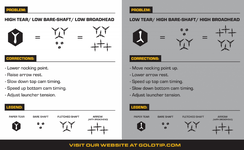Hey folks, this is only my second post but I frequent the forum as y’all are a wealth of knowledge. So thanks for keeping me squared away.
I’m new to archery (3rd season, 1st season taking it seriously) and have always been a tinkerer and a diy type. So I’m making a run at building my own arrows. The bare shafts are Gold Tip Hunter XT’s. Which I hear anything Gold Tip is widely accepted to be straight as hell, but since I’ll be starting from scratch, I’m entertaining the idea of tuning the piss out of the arrows.
My questions - how vital are nock tuning, insert tuning, and broadhead alignment? Which is most important? And with Easton brass insert, is it possible to insert tune and broadhead align simultaneously?
Other components of the arrows are 2” blazer vanes, deepower illuminated nocks, and either G5 Montec’s or Magnus Black Hornet’s.
Running these through a Mathews V3 31” with a 60lb draw weight (but will bump that to 65 in the future after a shoulder injury is addressed). The bow is more accurate than I am at this point. But I have premade arrows in my quiver that corkscrew like a mf in flight. So trying to change that. I chase whitetail with dreams of sika deer and antelope at some point in my life.
What say you?
I’m new to archery (3rd season, 1st season taking it seriously) and have always been a tinkerer and a diy type. So I’m making a run at building my own arrows. The bare shafts are Gold Tip Hunter XT’s. Which I hear anything Gold Tip is widely accepted to be straight as hell, but since I’ll be starting from scratch, I’m entertaining the idea of tuning the piss out of the arrows.
My questions - how vital are nock tuning, insert tuning, and broadhead alignment? Which is most important? And with Easton brass insert, is it possible to insert tune and broadhead align simultaneously?
Other components of the arrows are 2” blazer vanes, deepower illuminated nocks, and either G5 Montec’s or Magnus Black Hornet’s.
Running these through a Mathews V3 31” with a 60lb draw weight (but will bump that to 65 in the future after a shoulder injury is addressed). The bow is more accurate than I am at this point. But I have premade arrows in my quiver that corkscrew like a mf in flight. So trying to change that. I chase whitetail with dreams of sika deer and antelope at some point in my life.
What say you?



